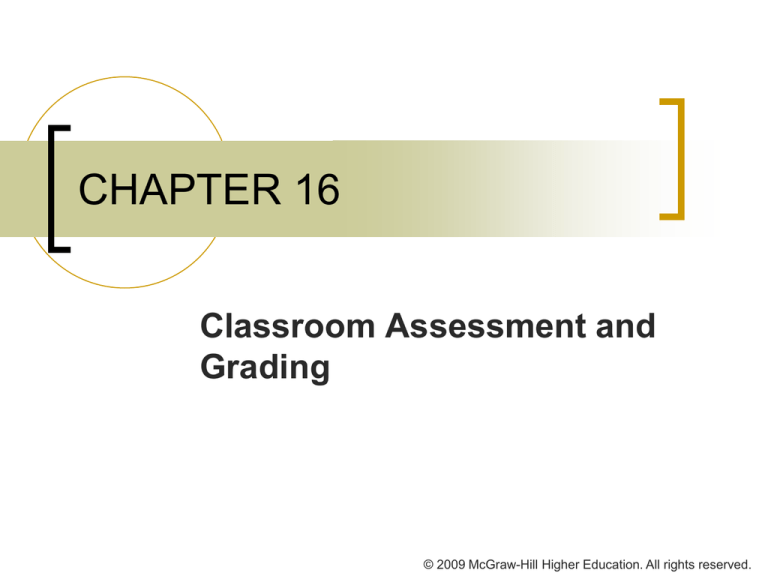
CHAPTER 16
Classroom Assessment and
Grading
© 2009 McGraw-Hill Higher Education. All rights reserved.
Learning Goals
1. Discuss the classroom as an
assessment context.
2. Provide some guidelines for
constructing traditional tests.
3. Describe some types of alternative
assessments.
4. Construct a sound approach to
grading.
© 2009 McGraw-Hill Higher Education. All rights reserved.
Classroom Assessment
The Classroom as
an Assessment
Context
Assessment as
an Integral Part
of Teaching
Making
Assessment
Compatible with
Contemporary
Views of Learning
and Motivation
Current
Trends
Creating Clear,
Appropriate
Learning
Targets
Establishing
High-Quality
Assessments
© 2009 McGraw-Hill Higher Education. All rights reserved.
Assessment as an Integral Part of
Teaching
Pre-Instruction
Assessment
Summative
Assessment
Formative
Assessment
© 2009 McGraw-Hill Higher Education. All rights reserved.
Learning Targets
1.
2.
Define what students should know and be
able to do, and
Provide criteria for judging whether
students have attained the stated learning
target.
© 2009 McGraw-Hill Higher Education. All rights reserved.
Establishing High-Quality
Assessments
Validity
Does the assessment measure what it
is intended to measure?
Reliability
Does the assessment yield stable and
dependable scores relatively free of
measurement errors?
Fairness
Do all students have equal opportunity
to demonstrate their knowledge and
skill?
© 2009 McGraw-Hill Higher Education. All rights reserved.
Current Trends in Classroom
Assessment
Include some performance-based methods of
assessment
Examine higher-level cognitive skills
Use multiple assessment methods
Use more multiple-choice items to prepare
students for taking high-stakes state-standardsbased tests
Have high performance standards
Use computers as part of assessment
© 2009 McGraw-Hill Higher Education. All rights reserved.
Classroom Assessment
Traditional
Tests
Selected-Response
Items
ConstructedResponse
Items
© 2009 McGraw-Hill Higher Education. All rights reserved.
Traditional Tests
Traditional tests are typically paper-pencil
tests in which students select from choices,
calculate numbers, construct short responses,
and write essays.
Two main types:
Selected-response items
Constructed-response items
© 2009 McGraw-Hill Higher Education. All rights reserved.
Selected-Response Items
Multiple-Choice Items
© 2009 McGraw-Hill Higher Education. All rights reserved.
Selected-Response Items
True-False Items
© 2009 McGraw-Hill Higher Education. All rights reserved.
Selected-Response Items
Short-Answer Items, Essay Items
© 2009 McGraw-Hill Higher Education. All rights reserved.
Classroom Assessment
Alternative
Assessments
Trends in
Alternative
Assessment
Performance
Assessment
Portfolio
Assessment
© 2009 McGraw-Hill Higher Education. All rights reserved.
Alternative Assessments
Authentic assessment means evaluating
a student’s knowledge or skill in a context
that approximates the real world or real life
as closely as possible.
Authentic assessment includes dance, music, art,
and physical education as well as papers, projects,
experiments, and portfolios.
© 2009 McGraw-Hill Higher Education. All rights reserved.
Performance Assessments
Performance assessments
are evaluated when
specific criteria (behaviors)
are performed
by the student.
© 2009 McGraw-Hill Higher Education. All rights reserved.
Guidelines for
Performance Assessments
Establishing a clear purpose
Identifying observable criteria
Providing an appropriate setting
Judging or scoring the performance
© 2009 McGraw-Hill Higher Education. All rights reserved.
Portfolio Assessments
Portfolio assessment consists
of evaluating a systematic and
organized collection of a
student’s work that
demonstrates the student’s
skills and accomplishments.
Artifacts: Students’
papers and homework.
Reproductions:
Documentation of a
student’s work outside
the classroom.
Attestations: Teachers’
or others’ documentation
of a student’s work.
Productions: Documents
prepared especially for
the portfolio.
© 2009 McGraw-Hill Higher Education. All rights reserved.
Using Portfolios Effectively
Establishing purpose
Growth portfolio
Best-work portfolio
Involving students in selecting
portfolio materials
Reviewing with students
Setting criteria for evaluation
Scoring and judging
© 2009 McGraw-Hill Higher Education. All rights reserved.
Classroom Assessment
Grading and
Reporting
Performance
The Purposes
of Grading
The Components
of a Grading
System
Some Issues
in Grading
Reporting Students’
Progress and
Grades to Parents
© 2009 McGraw-Hill Higher Education. All rights reserved.
Purposes of Grading
Motivational: Students
are motivated to achieve high
grades and to fear low grades.
Administrative: Help
determine class rank,
graduation, and promotion.
Informational: The grade
represents the teacher’s
summary judgment of student
performance.
Guidance: Help in
appropriate course selection
and identifying students with
special needs.
© 2009 McGraw-Hill Higher Education. All rights reserved.
Standards of Comparison
Norm-Referenced
Grading
Based on comparison of
student’s performance
with classmates
Referred to as “grading
on the curve”
Grading scale
determines what
percentages of students
get particular grades
Criterion-Referenced
Grading
Based on comparisons
with predetermined
standards or criteria
Referred to as “absolute
grading”
Grading is based on level
of mastery
© 2009 McGraw-Hill Higher Education. All rights reserved.
Grading and Reporting Performance
The Report Card
Written Progress
Report
Parent-Teacher
Conference
Standard method of reporting student
progress
Letter and numerical grades are
typically used, some checklists
Some report affective characteristics
Some provide teacher’s summative
comments
Reports can include student’s
performance on tests, projects, reports
Can include comments on student
motivation, cooperation, and behavior
Suggestions for parents
Provide an opportunity to give parents
useful information
Provide an avenue to develop parentteacher partnerships on the student’s
behalf
© 2009 McGraw-Hill Higher Education. All rights reserved.
Enter the Debate
Should grades be abolished?
YES
NO
© 2009 McGraw-Hill Higher Education. All rights reserved.
Crack the Case
The Project
1.
2.
3.
4.
5.
What are the issues involved in this
situation?
What did Mr. Andrews do wrong?
How should he have gone about
developing his alternative assessments?
How should he have developed his grading
guide?
What do you think of the practice of
including an effort grade on students’
projects? Why?
© 2009 McGraw-Hill Higher Education. All rights reserved.
Reflection & Observation
Reflection:
How have teachers assessed
your learning?
How did different types of
feedback affect your selfperceptions and motivation to
learn?
© 2009 McGraw-Hill Higher Education. All rights reserved.






